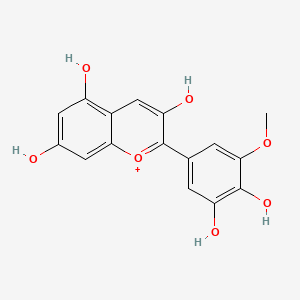| Authors | Title | Published | Journal | PubMed Link |
|---|---|---|---|---|
| Oh HD et al. | Abscisic acid stimulates anthocyanin accumulation in 'Jersey' highbush blueberry fruits during ripening. | 2018 | Food Chem | pmid:29120800 |
| Pereira SR et al. | Comparison of anti-inflammatory activities of an anthocyanin-rich fraction from Portuguese blueberries (Vaccinium corymbosum L.) and 5-aminosalicylic acid in a TNBS-induced colitis rat model. | 2017 | PLoS ONE | pmid:28329021 |
| Catola S et al. | The dominant allele Aft induces a shift from flavonol to anthocyanin production in response to UV-B radiation in tomato fruit. | 2017 | Planta | pmid:28516293 |
| Tatsuzawa F et al. | Red-purple flower color and delphinidin-type pigments in the flowers of Pueraria lobata (Leguminosae). | 2017 | Phytochemistry | pmid:28189342 |
| Ooe E et al. | Analysis and characterization of anthocyanins and carotenoids in Japanese blue tomato. | 2016 | Biosci. Biotechnol. Biochem. | pmid:26443075 |
| Shaipulah NF et al. | CCoAOMT Down-Regulation Activates Anthocyanin Biosynthesis in Petunia. | 2016 | Plant Physiol. | pmid:26620524 |
| Pantelić MM et al. | Identification and quantification of phenolic compounds in berry skin, pulp, and seeds in 13 grapevine varieties grown in Serbia. | 2016 | Food Chem | pmid:27283628 |
| Cui B et al. | Anthocyanins and flavonols are responsible for purple color of Lablab purpureus (L.) sweet pods. | 2016 | Plant Physiol. Biochem. | pmid:26995313 |
| Ahn JH et al. | De Novo Transcriptome Analysis to Identify Anthocyanin Biosynthesis Genes Responsible for Tissue-Specific Pigmentation in Zoysiagrass (Zoysia japonica Steud.). | 2015 | PLoS ONE | pmid:25905914 |
| Feng H et al. | Influence of cluster zone leaf removal on Pinot noir grape chemical and volatile composition. | 2015 | Food Chem | pmid:25466040 |
Petunidin
Petunidin is a lipid of Polyketides (PK) class. Petunidin is associated with abnormalities such as Vitamin A Deficiency, Night Blindness, Blind Vision, Chronic Disease and Heart Diseases. The involved functions are known as Drug Interactions, selective breeding, Signal Transduction, Protective Agents and Evolution. Petunidin often locates in Membrane, Body tissue, Gastrointestinal tract structure, Blood and Hepatic. The associated genes with Petunidin are TP53 gene, Genome and Genome, Human. The related lipids are Steroids and Total cholesterol. The related experimental models are Knock-out, Disease model and Animal Disease Models.
Cross Reference
Introduction
To understand associated biological information of Petunidin, we collected biological information of abnormalities, associated pathways, cellular/molecular locations, biological functions, related genes/proteins, lipids and common seen animal/experimental models with organized paragraphs from literatures.
What diseases are associated with Petunidin?
Petunidin is suspected in Chronic Disease, Obesity, Diabetes Mellitus, Non-Insulin-Dependent, Vitamin A Deficiency, Night Blindness, Blind Vision and other diseases in descending order of the highest number of associated sentences.
Related references are mostly published in these journals:
| Disease | Cross reference | Weighted score | Related literature |
|---|
No disease MeSH terms mapped to the current reference collection.
PubChem Associated disorders and diseases
What pathways are associated with Petunidin
There are no associated biomedical information in the current reference collection.
PubChem Biomolecular Interactions and Pathways
Link to PubChem Biomolecular Interactions and PathwaysWhat cellular locations are associated with Petunidin?
Visualization in cellular structure
Associated locations are in red color. Not associated locations are in black.
Related references are published most in these journals:
| Location | Cross reference | Weighted score | Related literatures |
|---|
What functions are associated with Petunidin?
Related references are published most in these journals:
| Function | Cross reference | Weighted score | Related literatures |
|---|
What lipids are associated with Petunidin?
Related references are published most in these journals:
| Lipid concept | Cross reference | Weighted score | Related literatures |
|---|
What genes are associated with Petunidin?
Related references are published most in these journals:
| Gene | Cross reference | Weighted score | Related literatures |
|---|
What common seen animal models are associated with Petunidin?
Knock-out
Knock-out are used in the study 'How can research on plants contribute to promoting human health?' (Martin C et al., 2011).
Disease model
Disease model are used in the study 'How can research on plants contribute to promoting human health?' (Martin C et al., 2011).
Animal Disease Models
Animal Disease Models are used in the study 'How can research on plants contribute to promoting human health?' (Martin C et al., 2011).
Related references are published most in these journals:
| Model | Cross reference | Weighted score | Related literatures |
|---|
